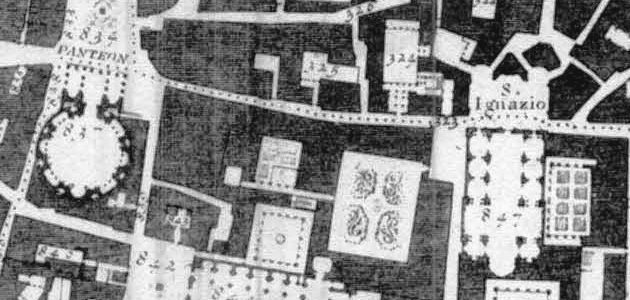There has always been a connection between architecture and visualization.
Not all visualization is about communicating data, sometimes visualizations show concepts. The core of what architects do is creating visuals that communicate complex concepts, processes and spaces.
Over hundreds of years, architects have developed and refined different drawing types and techniques that help to communicate these ideas to people. Let’s take a look at some drawings of the Pantheon to see how they communicate.
The drawings in this post come from two different sets. The more yellowish of the two are older drawings from “Les edifices antiques de Rome“ by Antoine Babuty Desgodetz in 1682. The grayscale drawings are the newer set from Francesco Piranesi in the 18th century.
Both of these sets of drawings were done after the construction of the Pantheon, but they are still good for communicating some of what would be necessary to create the building.
Even if you have never been to the Pantheon, these drawing sets will provide a feeling of what the building is like.
Download this post by entering your email below
Plan Drawings
Plan drawings are the most common architectural drawings. Think of them as a map of the building, as they provide a view of the layout from above. Imagine cutting horizontally through a building at about three feet (or approximately 100cm) above the floor level and drawing everything that was sliced through. In some drawings, the walls are shaded black, while in others they are given a lighter texture. The black portion in drawings is called Poché, and indicates everywhere that a wall or column was cut through for the drawing. Sometimes plan views also include more details than just what is at the 3′ level. They often include floor coverings, furniture, kitchen and restroom fixtures, appliances, or stairs.
Some plan view drawings happen at other levels in a building. In this drawing, there is a plan of the attic space, as well as a reflected ceiling plan, showing the inside surface of the dome.
Here’s another plan that shows the roof, as well as the coffered ceiling. Piranesi’s drawings go beyond the typical role of a plan view of communicating wall thickness, door and window locations, and the partitioning and sizes of a space. His drawings have much more detail in the shading and texturing, and are much more informative about the qualities of the space.
Section Drawings
Section drawings involve the same cutting technique as plans, although the cutting plane is vertical instead of horizontal. The point of a section view is to show the heights of each floor, and any complex structures like strange ceilings.
Sections are typically cut at right angles to the axes in a building, and unless their position is obvious, there are often reference lines on plan views to show where the section cuts fall. In the two drawing sets here, those reference lines are absent. The Desgodetz sections are fairly simple, cutting through the center of the dome along the longitudinal and transverse axes, with one section through the portico.
The Piranesi sections are more interesting. The shadows are shown as if the building actually were cut and sunlight was streaming in. This technique helps to communicate the depth of the building much more clearly than the Desgodetz sections.
In addition to the same sections as Desgodetz, Piranesi drew a portico section looking back towards the building, without the wooden roof structure.
Elevation Drawings
In addition to seeing the shape and space on the inside of a building, architects also need to communicate what the outside of a building will be like. One of the drawing types for this is the Elevation drawing. Elevation views show materials, texture profiles of the building, and heights of and between elements like windows and detailing.
Once again, the Piranesi drawings show much more detail.
Perspective Drawings
So far, all the drawings have been idealized views of the building that could never exist in real life. All the lines that are parallel in real life are drawn as parallel in the drawing. For a slightly more realistic view, architects use perspective drawings. Piranesi did one perspective of the Pantheon.
There are also other views similar to perspective drawings. Axonometric views show three sides of a drawing with the top rotated 45º, while the sides are skewed so verticals are vertical and horizontals are at 45º. Isometric views are similar, but using 30º angles and skewing the top and sides equally. In both axonometric and isometric projections, the lengths of every line is measurable, while in perspective drawings, the lengths vary depending on the location in the scene.
One interesting thing to note is the people in the drawing. These people are called scale figures, and are shown to help get an idea of the size of the building. Ideally, there would be more of these figures in the other drawings as well as the perspective. The Pantheon is a great example of how important these figures are, because without them it is difficult to grasp the scale of such a huge building.
Details
Often times, an overall view can’t show enough detail to communicate how something is constructed. When architects need to show more, they use detail views.
Detail Sections show cuts through a portion of a building in order to describe the construction technique and material use.
Other details simply show the shape and texture of things.
[slideshow id=11 w=618 h=978]
[slideshow id=10 w=618 h=897]
Site Plans
In addition to the building itself, it is important for architects to provide context for a building. Showing what is nearby, as well as the cardinal direction that a building faces is important for understanding the character the building will have. Neither Desgodetz nor Piranesi created a site plan for the Pantheon, but there is an amazing drawing of Rome by Giambattista Nolli from 1748, the Pianta Grande di Roma, now known as the Nolli Map. The map has an intense amount of detail. The next three images are all different zoom levels of the Nolli Map, showing increasingly more context around the Pantheon.
All of these drawing techniques developed very early in the history of architecture, and were so successful at communicating and recording the ideas, processes, and concepts that go into a building that they are still used widely today. As technology changes, the means of producing the drawings has evolved as well, however the drawing forms themselves have and will continue to stay mostly the same. Even the advent of digital 3D modeling has not changed the necessity of having a basic set of plans, sections, elevations, details, and site plans to get a building built.
Drew Skau is Visualization Architect at Visual.ly, a PhD Computer Science Visualization student at UNCC with an undergraduate degree in Architecture. You can follow him on twitter @SeeingStructure



























